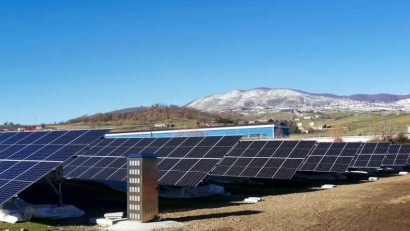
Spanning 6,000sqm, an area approximately the size of a football pitch, the 1122 two-sided photovoltaic 440Wp panels use the solar energy reflected off both the top and underside of each panel. This innovation enables greater generation of energy than a standard solar panel.
In full operation, it can generate 494 KWp with a yield capacity of around 700-750 MWh per year. Since the site currently uses less than 500kWp, The size of the Solar PV system is less than 500kWp, so the On-Site Exchange Scheme will be used to enable efficient compensation with surplus electricity fed into the network. Hitachi Rail also received a contribution by Basilicata government (30 % of whole life cost of solar Solar PV system), with the site being classified suitable to public local tender promoting energy efficiency and the use of renewable energy of companies.
The Tito Scalo facility is responsible for producing railway signalling’s components. It employs around 130 people and is important to Hitachi Rail’s business because it manufactures key components for On Board and Wayside Signal & Turnkey projects.
Hitachi Rail is committed to becoming a climate change innovator, and is working towards achieving this by:
In the period 2020-21, Hitachi Rail achieved a reduction of 30.5% of CO2 emissions, by both improving its energy consumption and through a wider use of energy from renewable sources. At COP26, Hitachi Group set new targets to achieve carbon neutrality throughout its entire value chain by 2050 - bolstering the existing commitment to achieve carbon neutrality across all its business sites by 2030. The investment in the new generation photovoltaic system at the Tito Scalo plant is part of this strategy, with similar initiatives being considered at Hitachi Rail sites around the world.
Hitachi Rail is also working to help decarbonize its supply chain through the covadis platform by selecting suppliers and partners who invest in the development of sustainable products and in production cycles that respect the environment. For example, its Caravaggio-Rock fleet of commuter trains are 95% recyclable, as well as being much lighter, and emitting 50% less CO2 emissions over the course of their lifetimes compared to the trains that they replaced. Hitachi Rail set out its wider science-based decarbonization strategy to achieving net-zero here.

